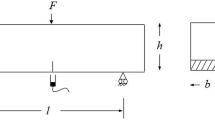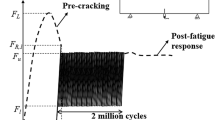Abstract
A fibre-strengthened brittle solid can crack and fracture in a number of ways and simple models can be used to describe quantitatively the fracture processes. This paper discusses some of these models and compares experimental measurements of cracking stress and toughness for two brittle fibrous composites with the theoretical predictions. The two brittle matrices are concrete and concrete impregnated with polymethylmethacrylate reinforced by discontinuous (short) high strength steel wires. It involved extracting a single steel wire from each brittle matrix to evaluate the debonding stress and pull-out stress as a function of fibre embedded length. These key material parameters and the energetics of cracking determined in three-point flexural experiments, together with the cracking and toughening equations are then used to characterize the fracture behaviour of fibrestrengthened concrete and polymer-concrete composites.
Similar content being viewed by others
References
J. Aveston, G. A. Cooper and A. Kelly, “The Properties of Fibre Composites” (IPC Science and Technology Press, 1971) pp. 15–24.
A. H. Cottrell, Proc. Roy. Soc. A282 (1964) 2.
A. Kelly, ibid. A282 (1964) 63.
Idem, ibid. A319 (1970) 95.
P. Hing and G. W. Groves, J. Mater. Sci. 7 (1972) 427.
J. L. Helfet and B. Harris, ibid. 7 (1972) 494.
J. O. Outwater and M. C. Murphy, 26th Annual Conference on Reinforced Plastics and Composites, Division of Society of Plastics Industries (1969).
F. F. Lange, Phil Mag. 22 (1970) 983.
A. G. Evans, ibid. 27 (1972) 1327.
J. Aveston and A. Kelly, J. Mater. Sci. 8 (1973) 352.
A. Takaku and R. G. C. Arridge, J. Phys. D: Appl. Phys. 6 (1973) 2038.
A. Kelly and C. Zweben, J. Mater. Sci. 11 (1976) 582.
D. J. Pinchin, Ph.D. Thesis, University of Cambridge (1977).
N. Hadjis and M. R. Piggott, J. Mater. Sci. 12 (1977) 358.
J. Aveston, R. A. Mercer and J. M. Sillwood, National Physical Laboratory Report SI No. 90/11/ 98 (1975).
J. Aveston, R. A. Mercer and J. M. Sillwood, “Composites — Standards, Testing and Design” (IPC Science and Technology Press, 1974) pp. 93–103.
J. Morton and G. W. Groves, J. Mater Sci. 11 (1976) 617.
W. W. Gerberich, Ph.D. Thesis, Lawrence Radiation Laboratory, University of California, Berkeley (1971).
L. B. Greszczuk, American Society for Testing and Materials Special Technical Publication 452 (1969) p. 49.
J. C. Aleszka and P. W. R. Beaumont, UCLA Report No. UCLA-ENG-7396 (1973) Department of Engineering and Applied Sciences.
Author information
Authors and Affiliations
Rights and permissions
About this article
Cite this article
Beaumont, P.W.R., Aleszka, J.C. Cracking and toughening of concrete and polymer-concrete dispersed with short steel wires. J Mater Sci 13, 1749–1760 (1978). https://doi.org/10.1007/BF00548738
Received:
Accepted:
Issue Date:
DOI: https://doi.org/10.1007/BF00548738




